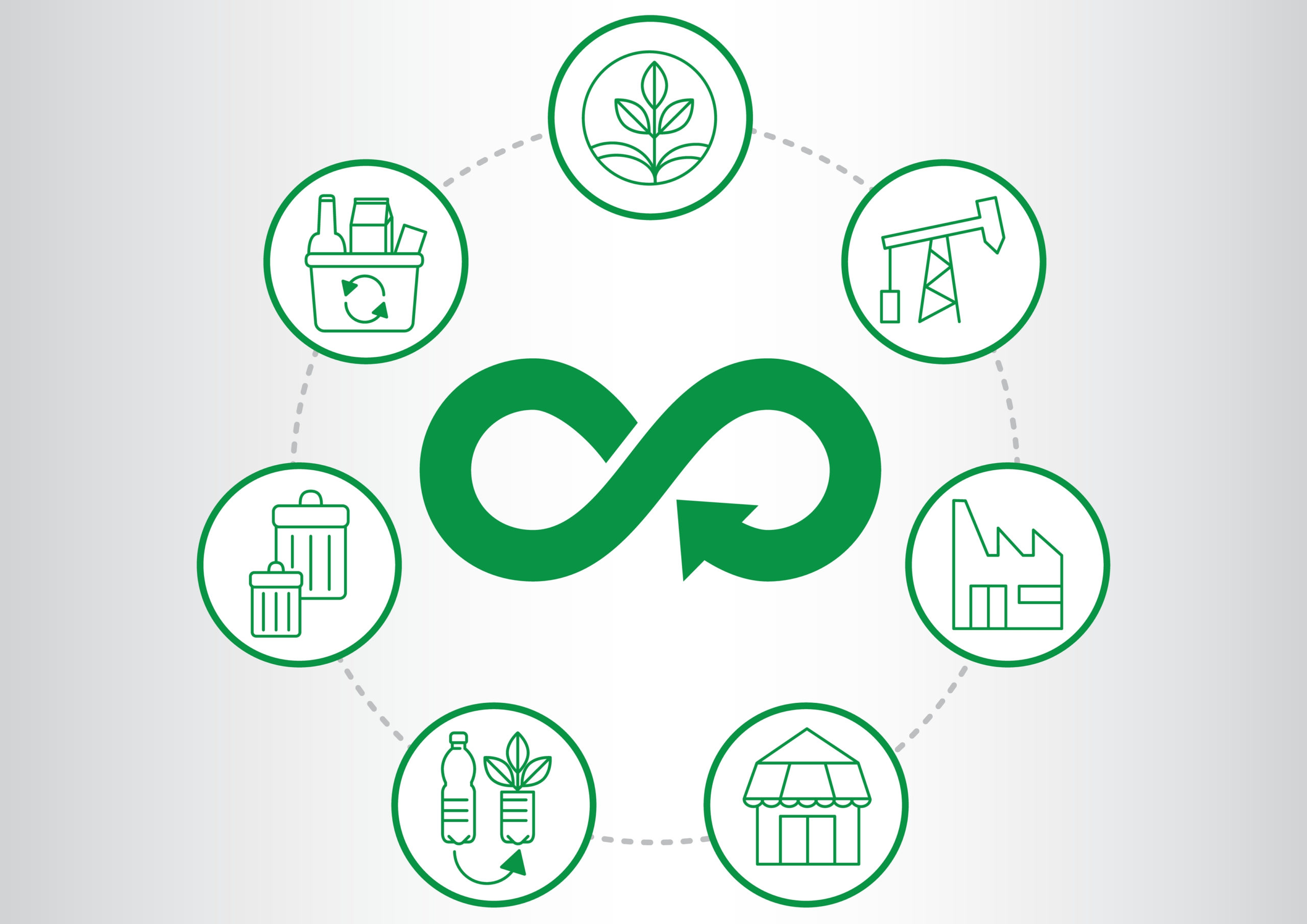Key Takeaways:
- Consumers are taking an increased interest in the welfare of our planet and environment.
- Sustainability isn’t just a moral imperative; it’s also a key business imperative.
- Circular supply chains incorporate a greater focus on sustainability, decreasing waste and reliance on renewable resources.
- This is in contrast to linear supply chains, which follow a more traditional flow of disposable goods and packaging.
- While the linear model serves an important purpose, its environmental impact has come under scrutiny.
- The benefits of the circular model can include reduced costs, increased innovation, and improved efficiencies.
- The iGPS closed-loop iDepot model featuring recyclable plastic pallets is a great example of the circular supply chain in action.

Global awareness of the effects of climate change is steadily increasing, and rising numbers of consumers are taking an interest in the welfare of our planet and how pollution impacts our air and waterways. Given that the largest part of any company’s carbon footprint is centered on its supply chain, enterprises are making greater investments in greener and cleaner logistics methods and approaches. Sustainability is more than a buzzword, and it’s more than the right thing to do for the planet and the sake of future generations; it’s also a vital business imperative. It’s no wonder that organizations are taking a closer look at the benefits of a circular supply chain.
What is a Circular Supply Chain?
A circular supply chain is one that incorporates a greater focus on sustainability and regeneration into the traditional flow of goods and materials. Whereas a linear supply chain progresses from raw materials to production, use, and disposal, a circular supply chain creates a continuous loop in which products and materials can be reused, remade, and recycled. This decreases waste as well as reliance on non-renewable resources. Developing a circular supply chain depends not only on a massive operational change, but also on a fundamental reimagining of how the supply chain works and provides value.
The optimal circular supply chain depends on several key principles:
- Products and packaging should be designed with an eye toward durability, reusability, repairability, and/or recyclability.
- Materials involved in the supply chain should remain in use for as long as possible.
- Waste should be treated not as a problem for disposal, but as a resource and opportunity for energy conservation.
When managed properly, a circular supply chain operates in a continuous loop. Material sourcing involves a focus on renewable, recycled, or perhaps biodegradable resources. Opportunities are identified to cut down on transportation legs to save both time and fuel. Reverse logistics are incorporated into the distribution network, enabling goods, packaging, and/or shipping platforms to flow back into the supply chain for reuse, repair, or recycling.
What is a Linear Supply Chain?
In contrast to a circular supply chain, a linear supply chain follows the traditional one-way flow of production and consumption. Raw materials are extracted, transformed through manufacturing processes into products, distributed to customers, and then discarded. There is minimal consideration for what happens to products and packaging at the end of their lifespan. While this model has been foundational to the growth of both industry and society, its wastefulness and inefficiencies are now under intense scrutiny.
The extraction of raw materials from natural resources such as fossil fuels involves significant disruptions to environments and ecosystem, and both the environmental and social impacts of manufacturing practices are often overlooked. A linear distribution network that is designed for maximum speed and convenience can generate a great deal of packaging waste and a large overall carbon footprint.
Furthermore, the design of the products, packaging, and shipping platforms in a linear supply chain rarely accounts for durability, longevity, and end-of-life considerations. Items in the typical linear supply chain can be disposable and difficult to repair or recycle, and with the exception of product returns or recalls, there are few built-in mechanisms for reverse logistics. The ultimate destination for many of these goods is the landfill or incinerator.
The bottom line is that while the advent and rise of the linear supply chain has been instrumental in meeting immense global demand, the limitations and potential harmful impacts of this model are increasingly apparent. And this is in clear misalignment with evolving customer preferences, which prioritize environmentally friendly sustainability practices.
The Benefits of Circular Supply Chains
While the concept of a circular supply chain sounds great in theory, its implementation requires an enterprise to overcome significant hurdles. Developing the strong infrastructure needed to support reverse logistics, recycling processes, and widespread consumer adoption can be both costly and difficult. Companies must also make investments in innovative product and packaging designs and tools to track and monitor materials throughout their lifecycle.
Nevertheless, in addition to the environmental advantages, the potential business benefits are considerable:
Reduced Costs
A circular supply chain minimizes the need for expensive raw material extraction and also cuts waste disposal costs. In some cases, waste streams can even be transformed into revenues. The production of more durable, recyclable goods can also reduce production demands.
Improved Brand Reputation
Circularity fosters stronger relationships with partners and consumers who increasingly value organizations that prioritize sustainability.
Better Risk Management
A circular supply chain can also reduce a company’s dependence on outside suppliers, including ones that produce scarce raw materials or operate in volatile markets, such as those with geopolitical instability or high incidence of natural disasters.
Increased Innovation
Businesses that operate circular supply chains must continuously rethink product design and processes to align with sustainability goals. This approach also fosters the development of more efficient recycling methods, new biodegradable materials, and high-tech tracking and traceability systems.
Improved Efficiency
A closed-loop system is often more efficient and optimized, because it enables more reuse and repurposing of materials, packaging, and even shipping platforms. It also minimizes the considerable effort and expense of waste disposal.
The Circular Supply Chain in Action
The optimal circular supply chain is well suited to the adoption of plastic pallets from iGPS. Our automation-friendly plastic pallets are durable, lightweight, and recyclable. Unlike the traditional wood block pallet that often ends up in a land fill after about 25 trips, a plastic pallet can complete up to 100 trips in the supply chain (actual, not lab-tested) and at the end of its lifespan it can be molded into a new pallet. It’s a true example of cradle-to-cradle sustainability.
Furthermore, when an iGPS plastic pallet arrives at a retailer, there is no need for time and fuel to be wasted by bringing that pallet to a distant depot for repair and redistribution, which involves yet another transportation leg. As part of our closed-loop iDepot model, the pallet can simply be inspected and returned directly to the pallet pool, to be used by the next manufacturer that needs it, creating both greater efficiencies and a lower overall carbon footprint.
While linear supply chains have been instrumental in driving industrial progress, the circular supply chain’s focus on environmental sustainability, resource efficiency, and long-term resilience positions it as the model for a thriving, sustainable future. Enterprises that adopt this philosophy will undoubtedly evolve with the industry.
Frequently Asked Questions:
What is the circular model of the supply chain?
The circular model of the supply chain focuses on reusing, recycling, and repurposing materials to minimize waste and extend the lifecycle of products. It aims to create a closed-loop system where resources are continuously cycled back into production.
What is a linear supply chain?
A linear supply chain is a traditional model where resources flow in a straight line: raw materials are extracted, transformed into products, distributed to consumers, and discarded as waste after use. It focuses on efficiency and cost-effectiveness but often ignores the environmental and resource implications. With no mechanism for recovering or reusing materials, the linear model relies heavily on finite resources and generates significant waste, making it increasingly unsustainable.
What are the benefits of circular supply chain?
A circular supply chain reduces environmental impact, conserves natural resources, and promotes sustainability. It also enhances cost efficiency by reusing materials and fosters innovation in product and packaging design. Ultimately, organizations that adopt a circular supply chain can enjoy increased reputation and consumer loyalty.
Companies that prioritize the efficiency and sustainability of a circular supply chain choose iGPS pallets for their shipping needs. The iGPS pallet is lightweight, more durable, and recyclable. To get started, call 1-800-884-0225, email a specialist at switch@igps.net, or visit our contact page.



